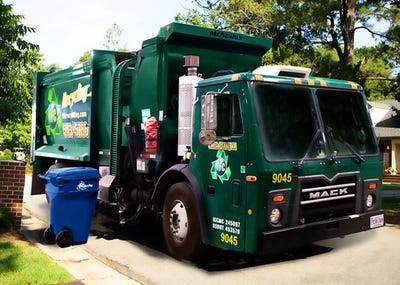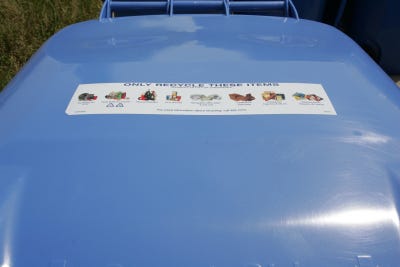RFID technology helps Chesapeake’s waste management division boost recycling and reduce tipping fees.
March 2, 2012
Jennifer Grzeskowiak, Contributing Writer
When the Southeastern Public Service Authority stopped providing recycling services to residents in Chesapeake, Va., the city and its waste management division had a decision to make: allow recycling to end or create their own program from scratch. With tipping fees at $145 per ton, Chesapeake decided to buy carts equipped with radio frequency identification (RFID) chips, contract with a hauler and implement a rewards system. The loss of one recycling program became an opportunity to increase diversion and improve operations using the RFID technology.
Laying the Groundwork
In 2009, Chesapeake was generating approximately 100,000 tons of waste per year and had a 4.5 percent recycling rate. One of the goals in putting together a new recycling program was to increase diversion, but also to be able to target neighborhoods that weren’t participating and encourage them to do so. One of the first orders of business was purchasing recycling carts. David Thompson, director of Chesapeake’s Waste Management Division, knew that switching from the 18-gallon bins that residents previously were using to larger 96-gallon carts would help increase the amount of material being recycled. Looking ahead, he also determined it would be worth the extra $1.50 per cart to add an RFID chip molded into the plastic underneath the lid of the container — a decision that already has paid off.
 Chesapeake chose local firm TFC Recycling to handle collection for its 65,000 households. Some aspects of residential recycling in Chesapeake remained the same, such as pickups every two weeks. But the new program also brought positive changes for residents, including a broadening of the types of materials that could be recycled. New to the recycling carts are corrugated cardboard, paperboard, mixed paper, magazines and junk mail.
Chesapeake chose local firm TFC Recycling to handle collection for its 65,000 households. Some aspects of residential recycling in Chesapeake remained the same, such as pickups every two weeks. But the new program also brought positive changes for residents, including a broadening of the types of materials that could be recycled. New to the recycling carts are corrugated cardboard, paperboard, mixed paper, magazines and junk mail.
But one of the major alterations Thompson wanted to make was implementing an accurate method for identifying which households weren’t participating in recycling so he could provide incentives for them to do so. He began discussions with TFC President Michael Benedetto on how to accomplish this. Because the bins had the RFID chips installed, they knew they already had some capability to track which individual residents weren’t recycling.
After collaborating with other industry professionals, Benedetto suggested they create Recycling Perks, a rewards-based program that gives residents points for recycling that can be redeemed online for rewards at local businesses. Residents set up an account online and accrue points every time they put out their bins, earning a maximum of $25 in rewards each month.
But before trying to increase participation through a rewards program or other efforts, Thompson wanted to establish a baseline for the recycling program by looking at how much tonnage would increase based on the larger carts and basic outreach. This outreach included a pamphlet and humorous videos introducing the system. One of the videos, for instance, lets residents know that they can request a 35- or 64-gallon cart if the larger size is too cumbersome.
Cart provider Cascade Engineering helped deploy the new carts over the course of five weeks at the end of 2009. They started with the Friday pickup route and then moved ahead one route at a time to Wednesdays, Thursdays and finally Tuesdays. Within one year, recycling tonnage had increased from 4,807 tons in 2009 to 15,447 tons in 2010.
RFID in Action
After the first year and the anticipated spike, Chesapeake’s waste management division was ready to begin testing other methods to increase participation. TFC agreed to install RFID readers on its collection trucks so that it could help more accurately measure residents’ recycling activity.
In spring 2011, Sonrai Systems spent approximately one week putting readers on TFC’s recycling trucks that service Chesapeake. When a truck pulls up in front of a cart equipped with an RFID chip, it automatically scans the chip and stores the cart’s serial number, the date and time, which truck is being used, and the longitude and latitude. That data is made available in real time for online monitoring by Chesapeake and TFC.
 In May 2011, with all of the elements in place, the parties were ready to launch the Recycling Perks program. Six months later Recycling Perks President Bill Dempsey began analyzing the collection data to determine which neighborhoods to target with outreach efforts. “To increase recycling, sometimes a city will just mail everyone,” Dempsey says. “That’s not really cost effective.” Instead, he is in the process of contacting residents that don’t recycle and offering them a free, indoor 12-gallon container to facilitate the collection of recyclables. He also makes them aware of rewards partners that are close to their homes. Later this year, he will approach residents with a strong track record for recycling about becoming block captains and encouraging their neighbors to participate.
In May 2011, with all of the elements in place, the parties were ready to launch the Recycling Perks program. Six months later Recycling Perks President Bill Dempsey began analyzing the collection data to determine which neighborhoods to target with outreach efforts. “To increase recycling, sometimes a city will just mail everyone,” Dempsey says. “That’s not really cost effective.” Instead, he is in the process of contacting residents that don’t recycle and offering them a free, indoor 12-gallon container to facilitate the collection of recyclables. He also makes them aware of rewards partners that are close to their homes. Later this year, he will approach residents with a strong track record for recycling about becoming block captains and encouraging their neighbors to participate.
While the initial goal of the RFID system was to better track recycling habits and increase participation, both Chesapeake and TFC have seen other benefits as well. The city has been able to keep track of its 65,000 bins and their locations. If a truck stops to empty a cart at a house and the cart icon on Chesapeake’s screen changes from green to red in a location across the city from where the truck has stopped, Thompson knows the cart has been moved. “There’s a lot of value in it from an inventory control standpoint,” Thompson says.
Similarly, TFC is able to better monitor its trucks. “We can know where our trucks are at any time,” Benedetto says. “We can see a breakdown and send out a different truck right away and see exactly where they left off. It’s getting us to the point where we are providing a more timely service.”
Thompson says Chesapeake will continue to explore ways to use the RFID technology to improve its operations. The city also has chips in its waste carts and over the next several years is converting its fleet to compressed natural gas (CNG) vehicles. As it makes the conversion, the city will look into installing readers on those vehicles as well.
In 2011, Chesapeake’s recycling rate increased another 7 percent to 16,509 tons. “It was one of those perfect storms where every group could bring something to the table,” Benedetto says.
Jennifer Grzeskowiak is a Laguna Beach, Calif.-based freelance writer.
You May Also Like


